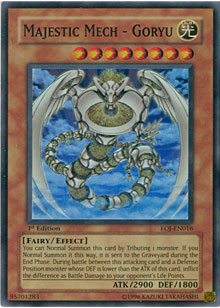 I’ve had a deck idea kicking around in the back of my mind for weeks now. You know the type—that kind of idea where there’re all sorts of floating concepts and possibilities, but no really clear path? It doesn’t happen all that often, but sometimes a new strategy just offers so many possibilities that I don’t have time to wrap my head around it. At least not quite as fast as I’d like.
I’ve had a deck idea kicking around in the back of my mind for weeks now. You know the type—that kind of idea where there’re all sorts of floating concepts and possibilities, but no really clear path? It doesn’t happen all that often, but sometimes a new strategy just offers so many possibilities that I don’t have time to wrap my head around it. At least not quite as fast as I’d like.
The basis of that idea was Valhalla, Hall of the Fallen. Overshadowed by its Premium Pack 2 comrade Mezuki, Valhalla is one of those cards that opens up so many possibilities that it’s difficult to tell what exactly you should use it for. Every couple of days for the past several weeks I’ve thought of something new—everything from spamming the field with multiple copies of Darklord Zerato to creating a new control deck based around Arcana Force XXI - The World. After writing about Herald of Orange Light I spent even more time considering the deck, but it wasn’t until a reader sent me his Valhalla build that I had a reason to stop coming up with ideas, and start making actual decisions about a concrete build.
Here’s what that reader sent me:
The main goal of the deck is to get Athena out for free and then use my Heralds to maintain a strong position on the field. Majestic Mech - Goryu and Majestic Mech - Ohka are usually the fodder of choice to get the Herald’s effects off, seeing as they make perfect Athena targets for revival. The deck can also get out Synchro monsters easily due to the Souls and Ohkas being perfect Synchro materials for Herald of Orange Light. I also use Beckoning Light to make sure I have a set of Heralds in hand to answer most issues.
The only main problem I seem to have is keeping enough cards in hand to make sure I can activate the Heralds when needed. I recently added Card of Safe Return, but have yet to test them.
—Thomas Pedigo, Bowling Green, KY
Here’s Thomas’s original build . . .
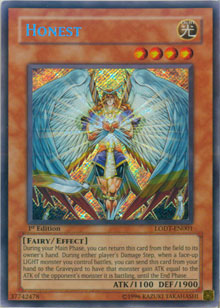 Valhalla—40 Cards
Valhalla—40 Cards
Extra Deck:
1 Goyo Guardian
1 Red Dragon Archfiend
1 Stardust Dragon
3 Avenging Knight Parshath
Thomas’s deck has three big strategic points. First, he uses a total of seven Herald monsters to try and control his opponents. Then, he uses Athena to set up a recursive strategy to get Majestic Mechs into play, drawing cards with Card of Safe Return. Third, Herald of Orange Light pulls double duty to bring out big Synchro monsters.
These ideas are all pretty good, but I’m not convinced that there’s enough space for all of them. Athena with three copies of Card of Safe Return and more easy-to-ditch low-level Fairies would be good on its own, though it sounds pretty slow for today’s competitive metagames. The Heralds are great control cards, but playing seven of them without some sort of self-sustaining offense seems very ambitious—like Thomas said, he frequently just runs out of cards. The strategy I like the best is actually the one Thomas has focused on the least: Synchros.
I think there’s a solid deck here, based on dropping big Fairies for free with Valhalla, Hall of the Fallen, and trading them up for Synchros when the time is right. The primary strength of Valhalla is that it lets you drop an enormous monster every turn without consuming a tribute or a normal summon. If we play to the card’s most basic and consistent strengths, then a little bit of defense will give us room to set up some very fancy stuff with Synchro monsters. If I tweak the deck correctly, I’ll even be able to intertwine those two themes and make it easy to leverage the monsters you summon with Valhalla into Synchro summons. Considering the ability to special summon any Fairy and then immediately normal summon a Tuner, it shouldn’t be hard to create a deck that can Synchro summon reliably. The trick will be selecting the right monsters to serve both purposes. I also need to make sure that I can get Valhalla out every game, more than once if needed.
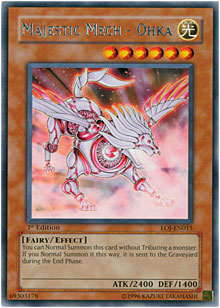 So we need to make some room. I really like the Majestic Mechs here: Majestic Mech - Ohka can be summoned in a pinch without tribute or Valhalla, so it’s a safe card to rely on in triplicate. If you have Valhalla on the field, great: go ahead and special summon it, and you’ll get to keep it past the end phase. But if you don’t have Valhalla at the moment, it’ll at least still be a playable monster. Alternatively, when you special summon Ohka you can normal summon Herald of Orange Light to immediately trade it for Stardust Dragon, Red Dragon Archfiend, or Avenging Knight Parshath. That’s awesome, and it’s going to be a lynchpin move for this deck.
So we need to make some room. I really like the Majestic Mechs here: Majestic Mech - Ohka can be summoned in a pinch without tribute or Valhalla, so it’s a safe card to rely on in triplicate. If you have Valhalla on the field, great: go ahead and special summon it, and you’ll get to keep it past the end phase. But if you don’t have Valhalla at the moment, it’ll at least still be a playable monster. Alternatively, when you special summon Ohka you can normal summon Herald of Orange Light to immediately trade it for Stardust Dragon, Red Dragon Archfiend, or Avenging Knight Parshath. That’s awesome, and it’s going to be a lynchpin move for this deck.
Majestic Mech - Goryu is great too, and together with Avenging Knight Parshath we’ll have a monster lineup that kicks out piercing damage with frightening consistency. Goryu isn’t quite as "safe" to play as Ohka, since you’ll always need a tribute monster or Valhalla to bring it to the field, but it’s just so impressive. If you want to put pressure on your opponent, summoning a 2800 ATK monster that punches through defense modes is a good way to do it.
So the Majestic Mechs stay. I really wish Athena were a level-8 monster, because if she was, we could run three copies of Trade-In to help this deck draw to its most important cards. Sadly she’s a level 7, and I feel like her part of the deck is just very slow. She’s another dead card if we don’t have Valhalla out, and I think that’s a big risk to take. I’m going to drop all three copies. The same goes for Soul of Purity and Light. There are a ton of monsters that could benefit from Valhalla, but Soul of Purity isn’t one of them, and it could make for rough openings. Ironically I’ll be adding some monsters that would make it easier to play with Soul of Purity and Light, but I won’t end up having room to use her.
Moving on, I don’t think there’s any way to fix Thomas’ one problem he mentioned: he runs out of cards when he plays his Heralds. The Heralds’ effects are exceedingly powerful, and because they’re so costly I don’t think it’s possible to use them as a consistent control engine 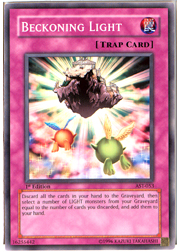 and actually have enough cards to win out afterward. Herald of Orange Light will stay because it’s a Tuner and its negation effect is incredible in the current environment, but I’m dropping both Herald of Green Light and Herald of Purple Light. You can side them if you’d like.
and actually have enough cards to win out afterward. Herald of Orange Light will stay because it’s a Tuner and its negation effect is incredible in the current environment, but I’m dropping both Herald of Green Light and Herald of Purple Light. You can side them if you’d like.
With Athena gone, there’s no reason to keep the two copies of Card of Safe Return around, and Card Destruction becomes a relic of the deck’s past. With a much lower focus on Heralds we can ditch Beckoning Light, and the three copies of Reckless Greed were never really needed to begin with. While they gave Thomas easy access to discard fodder for his Heralds earlier on, and may have gotten him to Valhalla, Reckless Greed is really at its best in either an OTK deck, or a strategy that can quickly set up a long-term defense plan. This deck doesn’t do either of those things, so Reckless isn’t a good choice in my opinion.
I’ve eliminated eighteen cards, which is just enough room for what I want to do with the deck. Let’s start with the easy additions first.
I immediately want to add one more copy of Valhalla, Hall of the Fallen. Yes, Thomas is running three copies of Hecatrice to search out his Halls, and yes, opening with three copies would be a rough beat. But the deck just doesn’t work without Valhalla, and since there’s so much spell and trap removal being played right now, it’s very important to run the maximum number allowed. Losing Valhalla to Gladiator Beast Bestiari or Lyla, Lightsworn Sorceress’s effect would stink, but the scenario becomes far more favorable if you could drop another Valhalla and then swing through that offending monster with Goryu on the following turn. Frankly, it’s not as if Hecatrice is a dead card on its own. If Hecatrice isn’t needed as a search agent, you can always special summon it and then normal summon Herald of Orange Light, using both as Synchro materials for Goyo Guardian.
With another Valhalla in the mix we can really open the floodgates for Synchros and choice Fairy monsters. Since we want to perform multiple Synchro summons each duel, some more Tuners are called for: Counselor Lily is the no-brainer choice since she’s a Fairy and will serve as discard fodder for Herald of Orange Light. She’s level 3 as well, broadening our range of options for Synchro summoning. In fact, my next addition is driven largely by Lily’s addition to the deck.
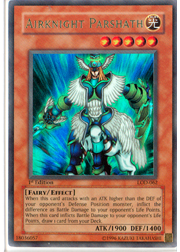 If we’re going to be summoning Fairies for free, I feel like we should be running arguably the fiercest Fairy of all time—Airknight Parshath. At level 5, the Parshath will be a perfect match for Counselor Lily, letting us bring out any level 8 Synchro. At the same time, the Parshath is a wonderful special summon on its own, quickly punishing any opponent that leaves him- or herself open to attack. You might be surprised at just how effective the Parshath can be against a deck like Gladiator Beasts, which normally wouldn’t mind taking a hit or two as long as you expose more cards to its destruction effects. A second copy of Honest will strengthen every monster in this deck, and will give you surprising opportunities for victory with this deck’s piercing damage.
If we’re going to be summoning Fairies for free, I feel like we should be running arguably the fiercest Fairy of all time—Airknight Parshath. At level 5, the Parshath will be a perfect match for Counselor Lily, letting us bring out any level 8 Synchro. At the same time, the Parshath is a wonderful special summon on its own, quickly punishing any opponent that leaves him- or herself open to attack. You might be surprised at just how effective the Parshath can be against a deck like Gladiator Beasts, which normally wouldn’t mind taking a hit or two as long as you expose more cards to its destruction effects. A second copy of Honest will strengthen every monster in this deck, and will give you surprising opportunities for victory with this deck’s piercing damage.
Honest is a defensive asset as well, making it easier to get out Synchros in a pinch. This deck has a significant, albeit not crippling number of potentially dead draws, so a little more defense seems like a good idea. Normally I’m not a big advocate of defensive strategies, but since this deck can roll defensive monsters into Synchros, two Nova Summoner cards and two copies of Arcana Force 0 - The Fool seem very solid.
The Fool is particularly good. While we’ve got Nova Summoner to bring it out in response to an attack, Yannick Dubeau-style, we’ve got one trick Yannick’s Counter Fools deck from Canadian Nationals didn’t have: Valhalla. Since The Fool is a Fairy, you won’t be forced to set The Fool if you draw it—that would deprive you of its coin flip effect. You can  special summon it with Valhalla right in defense mode instead, meaning that you can play Fool from your hand while still getting its effect. Nail the tails, and you’ve got a wall that basically requires Judgment Dragon or Torrential Tribute to get through.
special summon it with Valhalla right in defense mode instead, meaning that you can play Fool from your hand while still getting its effect. Nail the tails, and you’ve got a wall that basically requires Judgment Dragon or Torrential Tribute to get through.
Two Book of Moon cards will serve as chainable monster disruption, fending off attackers and leaving them vulnerable to a piercing monster on the following turn. Three copies of Bottomless Trap Hole provide more defense along with openings for our big monsters to make attacks, and Solemn Judgment defends Valhalla and our invested Synchros. That’ll be all for the main deck.
We’re not quite finished yet, though. An Extra deck with six monsters just seems like a waste to me—there’s really no reason not to have a full Extra deck of fifteen cards, since there’s no gameplay cost for running a complete toolbox. If you don’t have a complete Extra deck yet that’s understandable—after all, The Duelist Genesis isn’t even on retailer shelves yet. But the packs are available, and the retail release is pretty soon, so I’m going to design a complete Extra deck for Thomas’s strategy.
First up, we need another copy each of Goyo Guardian, Red Dragon Archfiend, and Stardust Dragon. You may even want a third Goyo if you have one. These three monsters along with Avenging Knight Parshath make up this deck’s core lineup of Synchro monsters, and only running one of each can leave you without a game-winning play on occasion. Thought Ruler Archfiend should be included as well. Thomas’s main deck doesn’t have any Psychic monsters, but Thought Ruler is a Psychic itself, and with the number of Brain Control and Mind Control cards I expect to be seeing soon, a monster that can shield itself from targeted effects is a great option to have.
Magical Android gets a one-copy nod for being a level-5 Synchro, and we’ll include Nitro Warrior and Junk Warrior too. You may not run the Tuners needed to Synchro summon those monsters, but if your opponent does, remember that you have Brain Control and Monster Reborn to borrow them. It costs you nothing to be prepared for those scenarios.
Gaia Knight, The Force of Earth takes the place of a third Goyo Guardian if you don’t have it. Gaia Knight is important, because like Goyo it’s a Warrior. That means it can contribute to the ATK of Colossal Fighter down the line, a little detail that becomes relevant when you note that Colossal Fighter is one of the few Synchros that can take down Gladiator Beast Heraklinos. The others are Red Dragon Archfiend, which must trade with Heraklinos in 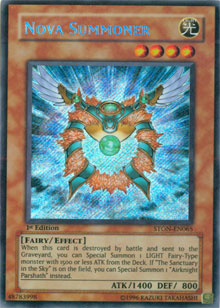 battle, and the tricky-to-summon Nitro Warrior.
battle, and the tricky-to-summon Nitro Warrior.
With those cards added, we’ve got a 40-card main deck and a 15-card Extra deck. Here’s a tally of the changes I’ve made:
+1 Red Dragon Archfiend
+1 Stardust Dragon
+1 Thought Ruler Archfiend
+1 Colossal Fighter
+1 Magical Android
+1 Nitro Warrior
+1 Junk Warrior
+1 Gaia Knight, The Force of Earth
Here’s the final build!
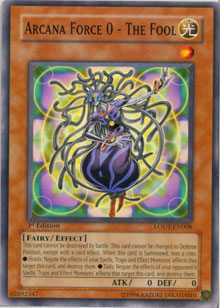 Valhalla—Jason’s Fix—40 Cards
Valhalla—Jason’s Fix—40 Cards
Extra Deck: 15
2 Goyo Guardian
2 Red Dragon Archfiend
2 Stardust Dragon
3 Avenging Knight Parshath
1 Thought Ruler Archfiend
1 Colossal Fighter
1 Magical Android
1 Nitro Warrior
1 Junk Warrior
1 Gaia Knight, The Force of Earth
The deck’s main game plan is to use Valhalla to drop big monsters for free. The average player these days can’t manage an opponent with high average ATK, and once this deck gets set up, there’s really nothing that can beat it in that department. Its central strategy is bolstered by a very strong defensive backbone, as well as the ability to negate monster effects and summon big Synchros.
Most decks tend to hold back on their bigger cards until they can do the most damage—after all, if you can only reliably play a single Dark Armed Dragon, you don’t tend to waste it early. That philosophy doesn’t fly here—the faster you can drop your first Goryu or Ohka, the better, especially if you can keep a flood of those monsters coming. Your opponent only has so many answers to that kind of play, and the faster he or she runs out of them, the faster you can make your really powerful moves—namely bringing down a big Synchro or setting up an invincible Arcana Force 0 - The Fool.
With that said, passing your first turn will likely be a common play. If you go first, the only monster you’ll want to summon or set will probably be Nova Summoner, and you won’t open with it reliably. Holding back on revealing that you have access to Valhalla, Hall of the Fallen can be smart, but remember that if you’re relying on Hecatrice to fetch your all-important spell, Trap Dustshoot can send it back to your deck. Play carefully, and don’t let your opponent alienate you from your central cards.
I’m not convinced that this strategy is ready to take on a Regional, but it can definitely win its share of local competitions and it’s a ton of fun to play. It may perform differently from duel to duel, but it’s got a solid defensive basis as well as superior negation abilities, so learn to use those to your advantage.
There are literally dozens of ways to play a Valhalla deck, but this one is my favorite. If you’ve been looking to put your copies to good use, throw this deck together and give it a try yourself!
—Jason Grabher-Meyer
Want to see your deck featured in The Apotheosis? Send your decklist, formatted like the one in this article, along with your name, location, and a short description of how the deck works, to metagamedeckfixes@gmail.com.